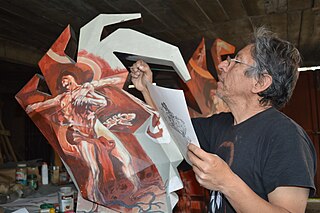Related Research Articles

Mexican cinema dates to the late nineteenth century during the rule of President Porfirio Díaz. Seeing a demonstration of short films in 1896, Díaz immediately saw the importance of documenting his presidency in order to present an ideal image of it. With the outbreak of the Mexican Revolution in 1910, Mexican and foreign makers of silent films seized the opportunity to document its leaders and events. From 1915 onward, Mexican cinema focused on narrative film.

Jorge Semprún Maura was a Spanish writer and politician who lived in France most of his life and wrote primarily in French. From 1953 to 1962, during the dictatorship of Francisco Franco, Semprún lived clandestinely in Spain working as an organizer for the exiled Communist Party of Spain, but was expelled from the party in 1964. After the death of Franco and the change to a democratic government, he served as Minister of Culture in Spain's socialist government from 1988 to 1991.
Events in the year 1994 in Mexico.

Bizcocho is the name given in the Spanish-speaking world to a wide range of pastries, cakes or cookies. The exact product to which the word bizcocho is applied varies widely depending on the region and country. For instance, in Spain bizcocho is exclusively used to refer to sponge cake. In Uruguay, most buttery flaky pastry including croissants are termed bizcocho, whilst sponge cake is called bizcochuelo. In Chile, the Dominican Republic, and Bolivia bizcocho refers to a sweet dough (masa) baked with local ingredients, similar to the bizcocho from Spain. In Ecuador the dough of a bizcocho can either be sweet or salty. The US state New Mexico is unusual in using the diminutive form of the name, bizcochito, as the name for a locally developed and very popular cookie.

The Guadalajara metropolitan area is the most populous metropolitan area of the Mexican state of Jalisco and the third largest in the country after Greater Mexico City and Monterrey. It includes the core municipality of Guadalajara and the surrounding municipalities of Zapopan, Tlaquepaque, Tonalá, Tlajomulco de Zúñiga, El Salto, Ixtlahuacán de los Membrillos and Juanacatlán.
The National Prize for Arts and Sciences is awarded annually by the Government of Mexico in six categories. It is part of the Mexican Honours System and was established in 1945. The prize is a gold medal and 520,000 pesos.

Muchachitas como tú is a teen Mexican telenovela produced by Emilio Larrosa for Televisa in 2007. It is an adaption of the Mexican telenovela Muchachitas, also produced by Emilio Larrosa. It premiered on April 23, 2007 and ended on November 9, 2007.

Tiempo de revancha is a 1981 Argentine political thriller film written and directed by Adolfo Aristarain and starring Federico Luppi, Julio De Grazia, Haydée Padilla, and Ulises Dumont. It was produced by Héctor Olivera and Luis O. Repetto. The music was composed by Emilio Kauderer. The film premiered in Argentina on July 30, 1981, and won 10 awards, including the Silver Condor for Best Film and Best Film in the Montréal World Film Festival.

Abrázame muy fuerte is a Mexican telenovela that aired from July 2000 to February 2001, under the production of Salvador Mejía Alejandre.

The Conservatorio Nacional de Música (CNM) is a music conservatory located in the Polanco neighborhood of Mexico City, Federal District, Mexico.

Ixtlahuacán de los Membrillos is a town and municipality in Jalisco in central-western Mexico. The municipality covers an area of 184.25 km². It is located north of the Chapala municipality.
La Heredera is a Mexican telenovela produced by TV Azteca. It marked the third reunion for Silvia Navarro and Sergio Basañez as protagonists. The series was then developed into an American telenovela by the title of American Heiress.

Antonio García Vega is a Mexican artist and member of the Salón de la Plástica Mexicana. He began exhibiting his work while still in school in the early 1970s and continues to do so, often working with his brother Mauricio García Vega. He works in mixed media to paint various forms of expression. His early work was mostly fantastic, with elements of eroticism but his later work has been darker as a means of expressing his own feelings and moods. His work has mostly been exhibited in Mexico, often in conjunction with other artists including a 2010 exhibition with his brother at various venues.

Las trampas del deseo, is a Mexican telenovela produced and distributed by Argos Comunicación and MundoFox broadcast by Cadenatres. Produced by Epigmenio Ibarra, Carlos Payan and Verónica Velasco.
Salud, dinero y amor is a Mexican telenovela produced by Emilio Larrosa for Televisa in 1997–98. Is a sequel of 1995 Mexican telenovela El premio mayor.

Confessions of a Taxi Driver is a 1949 Mexican comedy film directed by Alejandro Galindo and starring Adalberto Martinez, Lilia Prado and Julio Villarreal.

The death of Giovanni López Ramírez occurred on 4 May 2020, in the municipality of Ixtlahuacán de los Membrillos, Jalisco, Mexico as a result of his arrest by police officers. He was allegedly arrested for not wearing a face mask during the COVID-19 pandemic in Mexico. He died at a hospital with traumatic brain injury and with a gunshot wound to his leg. Public outcry over his death erupted one month later, due to a video of his arrest going viral on social media and inspired by the George Floyd protests. Protests against police brutality began in Jalisco on 4 June 2020, and spread to other areas in Mexico.

The Rebel is a 1943 Mexican musical drama film directed by Jaime Salvador and starring Jorge Negrete, María Elena Marqués and Julio Villarreal. It was shot at the Clasa Studios in Mexico City. The film's sets were designed by the art director Jorge Fernández. Inspired by the novel Dubrovsky by Alexander Pushkin, it shifted the setting from Russia to Mexico.

The 38th federal electoral district of the State of Mexico is one of the 300 electoral districts into which Mexico is divided for elections to the federal Chamber of Deputies and one of 40 such districts in the State of Mexico.
References
- ↑ "Jorge Federico de la Vega Membrillo". ADN Político. Archived from the original on 3 March 2016.
- ↑ "Perfil: Dip. Jorge Federico de la Vega Membrillo, LXII Legislatura". Sistema de Información Legislativa (SIL). SEGOB . Retrieved 6 September 2013.